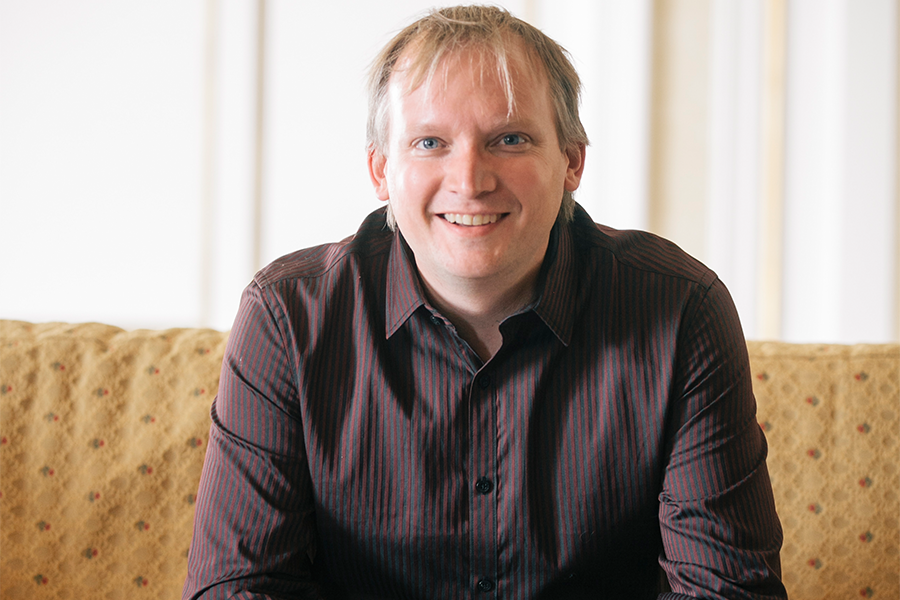
Shining a light on psychology research
If you flip through a magazine and pay close attention to the ads, Lorin Elias is confident most of the photos you see will be lit from the top-left.
By HenryTye GlazebrookWhile direction of lighting can be a subtle difference between two ads, it is one that Elias, a professor of psychology, said can be the difference between a customer choosing one product over another—whether the advertiser intended it to or not.
"I can't find any record of it being an intentional choice on the part of the photographer or an ad agency. I know it's happening; I can record it in practically any magazine," said Elias, interim dean of student affairs with the U of S College of Arts and Science.
"What I think happens is people shoot a bunch of pictures, they lay them out either on a real tabletop or on a screen, and they pick the one that they like."
Elias is interested in the changes that something as simple as direction or location can have on the way humans perceive the world around them, and vice versa. He refers to the concept as scanning biases.
It is an area of research with expansive potential—everything from where someone sits in a classroom to visual storytelling in film and even the perceived closeness of a car trailing behind your own in your left versus right rear view mirrors can be effected by scanning biases—but advertising is an easy entryway for Elias and his team of graduate students to research the subject.
In consultation with the Edwards School of Business, Elias and Jennifer Hutchinson, an honours student at the time, developed a magazine spread for an invented brand of watches they called Tigvar. The mock advertisement was shown to study participants twice, once normally and once inverted horizontally to reverse the lighting from upper-left to upper-right.
"We present these two images and you ask the person which watch they're more likely to buy. They're the exact same image, just flipped. There's a strong preference for the left-lit one—and that's whether it's for a watch or a show or a car, it didn't matter," Elias said.
Elias found even children's drawings, wherein large, corner-crowding suns often explicitly define the source of light, conveyed vastly different emotions based on whether the light source came from the top-left or top-right.
"The ones I found that were lit from the top-right are not happy images. The rightward ones, to me, looked almost a bit creepy," he said.
The reason behind these choices lies in the parietal lobes, two right and left sections of the brain that are specialized to determine both where objects are in space and where the body is relative to those objects. It is also the part of the brain that identifies how brightly an area is lit.
Since the right half of the brain is dominant in most people, and has the bulk of its sensory information fed to it from the left side of space, the right parietal lobe develops a natural preference for objects to the left of the body.
"What you'll find is people actually spend a little more time paying attention to objects in the left side of space. If you ask them questions about comparing things in the left and the right, like say you put two things up that are equivalent in brightness and you ask which one looks brighter, they'll say the one on the left," Elias said.
Since the same logic applies to how people perceive their own position in the world, this bias can have a similar effect on posing for photographs.
Regardless of light source, Elias' research has shown about two-thirds of people tend to favour the left side of their face being photographed. This phenomenon becomes even more prominent if instruction is given.
"If you tell the person they're about to leave their family for a few months and they're shooting a portrait for the mantle—you want them to look as loving as possible—they'll really accentuate that leftward bias," Elias said.
"When people are trying to convey emotion, and especially positive motion in a picture, they show the left of the face."
Given the left-to-right nature of English reading, Elias also looked into whether or not language played a role in developing this bias. He and graduate student Austin Smith specifically sought out Urdu and Farsi speakers, on account of those languages' right-to-left text scanning, and revealed little change in their findings.
"This wiring difference that most of us have with the right parietal lobe being specialized for certain judgements, that exists across cultures. That's a hardwired, genetic thing," he said, though he added that developing in a culture using predominantly right-to-left reading does slightly weaken the bias.
Looking forward, Elias said he is considering broadening his research to explore areas where people are not advertising products, but themselves.
"I'm actually curious about how this would work for dating sites as well, how someone would use lighting to portray themself on eHarmony or Tinder or whatever," he said. "You would definitely want a left cheek, left-lit profile."

